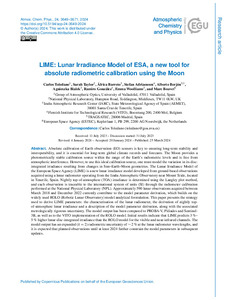Por favor, use este identificador para citar o enlazar este ítem:
http://hdl.handle.net/20.500.11765/15733
LIME: Lunar Irradiance Model of ESA, a new tool for absolute radiometric calibration using the Moon
Registro completo de metadatos
| Campo DC | Valor | Lengua/Idioma |
|---|---|---|
| dc.contributor.author | Toledano, Carlos | es_ES |
| dc.contributor.author | Taylor, Sarah | es_ES |
| dc.contributor.author | Barreto Velasco, África | es_ES |
| dc.contributor.author | Adriaensen, Stefan | es_ES |
| dc.contributor.author | Berjón, Alberto | es_ES |
| dc.contributor.author | Bialek, Agnieszka | es_ES |
| dc.contributor.author | González, Ramiro | es_ES |
| dc.contributor.author | Woolliams, Emma R. | es_ES |
| dc.contributor.author | Bouvet, Marc | es_ES |
| dc.date.accessioned | 2024-04-01T09:00:14Z | - |
| dc.date.available | 2024-04-01T09:00:14Z | - |
| dc.date.issued | 2024 | - |
| dc.identifier.citation | Atmospheric Chemistry and Physics. 2024, 24(6), p. 3649–3671 | es_ES |
| dc.identifier.issn | 1680-7316 | - |
| dc.identifier.issn | 1680-7324 | - |
| dc.identifier.uri | http://hdl.handle.net/20.500.11765/15733 | - |
| dc.description.abstract | Absolute calibration of Earth observation (EO) sensors is key to ensuring long-term stability and interoperability, and it is essential for long-term global climate records and forecasts. The Moon provides a photometrically stable calibration source within the range of the Earth's radiometric levels and is free from atmospheric interference. However, to use this ideal calibration source, one must model the variation in its disc-integrated irradiance resulting from changes in Sun–Earth–Moon geometries. The Lunar Irradiance Model of the European Space Agency (LIME) is a new lunar irradiance model developed from ground-based observations acquired using a lunar radiometer operating from the Izaña Atmospheric Observatory near Mount Teide, located in Tenerife, Spain. Nightly top-of-atmosphere (TOA) irradiance is determined using the Langley plot method, and each observation is traceable to the international system of units (SI) through the radiometer calibration performed at the National Physical Laboratory (NPL). Approximately 590 lunar observations acquired between March 2018 and December 2022 currently contribute to the model parameter derivation, which builds on the widely used ROLO (Robotic Lunar Observatory) model analytical formulation. This paper presents the strategy used to derive LIME parameters: the characterisation of the lunar radiometer, the derivation of nightly top-of-atmosphere lunar irradiance and a description of the model parameter derivation, along with the associated metrologically rigorous uncertainty. The model output has been compared to PROBA-V, Pléiades and Sentinel-3B, as well as to the VITO implementation of the ROLO model. Initial results indicate that LIME predicts 3 %–5 % higher lunar-disc-integrated irradiance than the ROLO model for the visible and near-infrared channels. The model output has an expanded (k=2) radiometric uncertainty of ∼ 2 % at the lunar radiometer wavelengths, and it is expected that planned observations until at least 2024 further constrain the model parameters in subsequent updates. | es_ES |
| dc.description.sponsorship | This research has been supported by the European Space Agency (contract no. 4000121576/17/NL/AF/hh) and the European Commission Research Infrastructure Action under ACTRIS-IMP (grant agreement no. 871115). | es_ES |
| dc.language.iso | eng | es_ES |
| dc.publisher | European Geosciences Union | es_ES |
| dc.rights | Licencia CC: Reconocimiento CC BY | es_ES |
| dc.subject | Radiometric calibration | es_ES |
| dc.subject | Moon | es_ES |
| dc.subject | Lunar Irradiance Model | es_ES |
| dc.subject | Earth observation | es_ES |
| dc.title | LIME: Lunar Irradiance Model of ESA, a new tool for absolute radiometric calibration using the Moon | es_ES |
| dc.type | info:eu-repo/semantics/article | es_ES |
| dc.relation.publisherversion | https://doi.org/10.5194/acp-24-3649-2024 | es_ES |
| dc.rights.accessRights | info:eu-repo/semantics/openAccess | es_ES |
| Colecciones: | Artículos científicos 2023-2026 | |
Ficheros en este ítem:
| Fichero | Descripción | Tamaño | Formato | ||
|---|---|---|---|---|---|
| ACP_Toledano_2024.pdf | 3,26 MB | Adobe PDF |  Visualizar/Abrir |
Los ítems de Arcimis están protegidos por una Licencia Creative Commons, salvo que se indique lo contrario.





